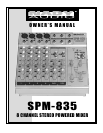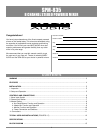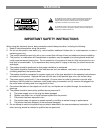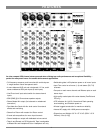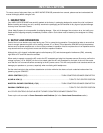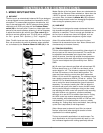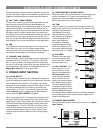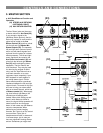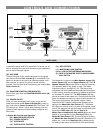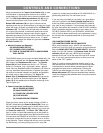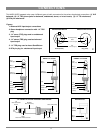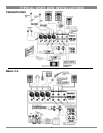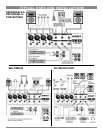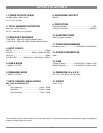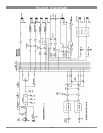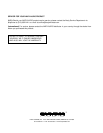
system into a Nady power conditioner PCL-800/810/815 or a
good quality power strip, for one-button turn-on.
If you are using a turntable in your setup it is a good idea to
connect it’s ground to the Phono Ground Terminal (31) to
avoid hum and/or possible shock.The SPM-835 is fused for
your (and its own) protection. If a fuse blows, disconnect the
AC cord, and replace the fuse with a 2.0A SLO-BLO (5x20mm
250V), available at electronics stores or your dealer (or a 1.0A
SLO-BLO, 5x20mm 250V, if your SPM-835 is a 220V-240V
unit). If the fuse blows continuously upon replacement, unplug
the unit and refer to qualified personnel for servicing before
further use.
(28) PHANTOM POWER SWITCH
(12) PHANTOM POWER ON LED INDICATOR
When using condenser mics, +48VDC can be switched
globally on or off to the XLR mic inputs for all mono channels
(also see MONO INPUT SECTION, MIC INPUTS). When this
switch is in the “ON” position, the Phantom Power On LED
Indicator (12) will light, and +48VDC will be provided
between pins 2 and 3 of all the mono Mic input XLR connec-
tors. If you don’t need phantom power, be sure to turn this
switch to the “OFF” position.
[Note: It is safe to connect balanced dynamic mics or line
level devices even if this switch is on, but connecting unbal-
anced devices or devices whose transformers are center-
grounded will cause hum or malfunctions. Shorting the
+48VDC can also damage your mixer. Also, turn down the
Master Mix control (17) to prevent possible sharp transient
noise from damaging the speakers when turning the phantom
power on or off.]
CONTROLS AND CONNECTIONS
10
being connected and the Tape In Level Control (18), so care
must be taken in adjusting these levels so as to achieve
proper balance in the final mix and to prevent overload distor-
tion. The LED Output Metering Indicators (19, 20) can be
used to maintain proper levels in the master mix. The L/R
Normal LED Indicators (20) will light to indicate normal
operating levels and you should always try to keep your levels
within this range. Overload is indicated by the L/R Peak LED
indicators (19). The Peak LEDs will light when the master
mix is going into overload. It detects the peak level and will
illuminate at 3dB before clipping to warn that the signal is
approaching overload. You do not want the Peak LED to light
except very intermittently during a take or a mix. If it does
light persistently, reduce the master mix gain with the Master
Mix Gain Control (17).
c. Monitor Function and Operation
(26) HEADPHONES OUTPUT
(22) PHONES LEVEL CONTROL
(21) TAPE IN TO MASTER/TAPE TO HEADPHONES
ONLY SWITCH
The SPM-835 allows you to monitor the Main Master Mix. The
signal level is adjusted with the Phones Level control (22)
and routed to the Headphones (26) output. The Phones
Output (26) will feed headphones and is a 1/4” TRS jack,
wired: tip = left signal, ring = right signal, sleeve = ground.
(Note: Use only headphones with an impedance >50 Ohms or
you may experience some distortion.) If desired, this output
can also be connected instead to an amplifier and speakers
for control room or stage monitoring. The Tape In To
Master/Tape To Headphones Only Switch (21) can be set
to the “up” position to route the signal input to the Tape In
jacks (15) to the headphones for selective monitoring of the
Tape In signal only.
d. Power Connection and Switches
(29) AC POWER IN SOCKET
(27) MAIN POWER SWITCH
(13) POWER ON LED INDICATOR
(30) FUSE HOLDER
(31) PHONO GROUND TERMINAL
Check the power source for the proper voltage (115VAC or
230VAC) noted below the Power In Socket (29). Once you
have connected the AC power cord to the AC power source
and the AC Power In Socket (29), switch on your mixer with
the Power On switch (27). The Power “ON” LED (13) will
light up. Allow 1 minute after powering up for the system to
reach equilibrium before setting input gains and other levels.
You can leave the SPM-835 on all the time. It is conservative-
ly designed, so heat build up isn’t a problem even in 24-hour-
a-day operation. There’s nothing that will burn out or get used
up. Alternatively, you can just plug every unit in your total



